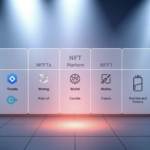Now Reading: Discover AI Powered Crypto Futures Trading Strategies
- 01
Discover AI Powered Crypto Futures Trading Strategies
Discover AI Powered Crypto Futures Trading Strategies

Welcome. This introduction shows how modern systems turn vast market data into clear signals and disciplined execution for futures-focused setups.
Open-source platforms like Freqtrade with FreqAI, FinRL, Nautilus Trader, Jesse, and TensorTrade offer robust building blocks. They automate 24/7 order execution, analyze historical and live feeds, and help reduce emotional bias.
Futures differ from spot: leverage, margin, funding rates, and liquidations can magnify gains and losses. Start with tight risk controls, realistic slippage and fee models, and secure API keys before going live.
Core workflow is simple: collect and clean data, engineer features, train and validate a model, translate signals into orders, and monitor live performance. Practical playbooks include scalping, momentum rotation, and cross-exchange arbitrage aligned to capital and time horizon.
Key Takeaways
- Convert large datasets into actionable signals and disciplined execution.
- Futures need strong risk controls from day one.
- Open-source stacks speed development but require setup and oversight.
- Simulate slippage, fees, and rate limits before live runs.
- Schedule regular model retrains and A/B tests for robustness.
What AI-Powered Futures Trading Means Today
Today’s model stacks fuse price, volume, order book, and sentiment to produce probabilistic trade signals.
Definition: This approach uses models that process live and historical data to generate probability scores and to execute leveraged positions with preset risk limits. It automates order routing across exchanges while enforcing stops and exposure caps.
Automation runs 24/7, but human oversight is still vital. Systems cut emotional bias and speed execution, yet market conditions can shift fast and require manual intervention.
- Common inputs: price/volume, order book depth, funding rates, and social sentiment fused for better signals.
- Exchange APIs enable automation but demand secure keys, rate-limit handling, and failover logic.
- Paper trading and free plans validate logic under realistic fee and slippage assumptions before risking capital.
- Template approaches like grid or DCA can teach mechanics, but adapt them for leverage, margin, and liquidation thresholds.
| Input | Purpose | Risk Control |
|---|---|---|
| Price & Volume | Direction and momentum | Stop-loss, size limits |
| Order Book | Execution quality | Rate-limit handling |
| Funding & Sentiment | Bias and regime cues | Exposure caps |
AI powered crypto futures trading strategies
Successful setups combine clean data flows, reliable models, precise execution, and strict loss controls.
Core components begin with data pipelines that deliver clean historical samples and real-time feeds for labeling and feature building.
- Data: price, volume, funding, basis, open interest and order book snapshots.
- Model: direction, probability, and expected-return labels that scale position size to signal confidence and volatility.
- Execution: event-driven engines for low-latency orders or batch handlers for swing horizons.
- Risk: max position sizes, daily loss caps, and automatic de-risking rules to limit blowups from leverage.
Leverage magnifies small forecasting errors into large PnL swings. Enforce strict position limits, trailing stops, and volatility-aware sizing.
| Use case | Latency need | Typical features |
|---|---|---|
| Scalping | Low | Order book imbalance, spread, RSI |
| Swing | Moderate | MACD, funding rates, open interest |
| Arbitrage | Very low | Cross-venue basis, latency monitoring |
Mapping User Intent: Profit, Protection, and Process
Start by naming the outcome you care about: steady growth, low drawdowns, or high absolute returns. Clear goals let you match leverage, holding periods, and execution style to real limits.
Maximizing edge while minimizing drawdowns means turning targets into rules. Help users rank priorities like Sharpe, max drawdown, or capital preservation. That ranking guides position sizing bands and risk budgets.
Practical workflow for consistent results
- Convert profit targets into size bands and enforce stop-losses and daily circuit breakers to avoid tail losses.
- Use paper trading to validate settings, and set daily loss limits before going live.
- Formalize processes: data checks, training cadences, deployment checklists, and alert thresholds.
- Create dashboards that show realized vs. expected performance, hit-rate drift, and drawdown envelopes.
- Run pre-mortems to list failure modes (data gaps, exchange outages, regime shifts) and predefine mitigations.
| Intent | Control | Monitoring |
|---|---|---|
| Absolute returns | Higher leverage band; wider stops | Daily P&L and position limits |
| Capital preservation | Low leverage; tight trailing stops | Max drawdown alerts and circuit breakers |
| Risk-adjusted growth | Volatility-aware sizing; stop-loss tiers | Sharpe proxy and hit-rate tracking |
For traders and platform users, map intent to clear procedures so the system behaves predictably. Regular reviews keep risk and management aligned with goals and maintain long-term performance.
Choosing Your AI Trading Stack: Freqtrade, FinRL, Nautilus Trader, Jesse, TensorTrade
Your software stack sets the tempo for data ingestion, model experiments, and order execution.

Start by matching goals to tool strengths. Some projects are research-first, while others focus on low-latency execution or simple go-live paths.
- Freqtrade + FreqAI: End-to-end Python stack with CCXT connectors and on-the-fly model retraining. Ideal for backtest-to-live workflows across multiple exchanges.
- FinRL & TensorTrade: Research frameworks for reinforcement learning. Use them to prototype agents and tune reward signals before moving to production layers.
- Nautilus Trader: Event-driven, Python/Rust mix built for low-latency, multi-venue routing and order book-driven execution on major venues.
- Jesse: Deterministic backtests, AI-assisted optimization, and a commercial live plugin for a simpler path to a production bot.
Trade-offs to weigh: ease-of-use versus performance engineering, open-source flexibility versus licensed components, and research speed versus production readiness.
| Tool | Strength | When to pick |
|---|---|---|
| Freqtrade | CCXT integration, retrain support | End-to-end live backtest cycles |
| FinRL / TensorTrade | RL research, modular models | Agent prototyping and reward experiments |
| Nautilus / Jesse | Low-latency routing / deterministic backtests | Order book strategies or fast go-live |
Choose a platform that fits your engineering bandwidth and the execution needs of your plan. Strong community support and clear features cut time to first live test.
Exchange Connectivity and Market Access for Futures
Access to multiple venues lets a single bot route orders to the best market. A unified connector reduces engineering overhead but does not remove per-exchange work.
CCXT offers a common API to major exchanges like Binance, Bybit, OKX, Kraken, and KuCoin. Nautilus Trader adds native connectors for Binance (spot/US/futures), Bybit, Coinbase, dYdX, and OKX for lower-latency paths.
API keys, scopes, and security
Store keys encrypted and grant least-privilege scopes. Restrict keys to trading only and avoid withdrawal rights for automated systems.
Rotate keys regularly and log access. These steps reduce the blast radius from a compromised key.
Rate limits and execution nuances
Exchanges differ in tick size, min qty, leverage caps, and margin curves. These affect order validity and liquidation risk.
Use rate-limit-aware batching and exponential backoff to avoid throttle blocks during heavy data pulls or rapid order adjustments.
- Validate symbol mapping and endpoints per venue before live runs.
- Paper trading per exchange helps check liquidation logic and margin profiles.
- Monitor latency, order rejections, and fill quality as part of normal support checks.
| Area | CCXT / Connector | Impact on execution |
|---|---|---|
| Endpoint differences | Futures vs spot paths | Parameter formats and order types vary |
| Rate limits | Per-minute and burst rules | Requires batching, backoff, and retry logic |
| Security | Key scopes, rotation | Least-privilege limits damage from leaks |
| Testing | Paper/staging modes | Validates symbol mapping and margin rules |
Building the Data Pipeline: Historical, Real-Time, and Order Book Feeds
A resilient data pipeline starts with reliable historical records and fast live feeds. Collecting both sets lets a system learn past behavior and react to sudden moves in the book.

Sourcing and cleaning historical data
Pull historical candles and trades from exchange APIs or via CCXT connectors. Include order book snapshots and deltas for microstructure signals.
Cleaning rules: align time zones, de-duplicate trades, forward-fill short gaps only, and validate price and volume integrity before training a model.
Streaming market data and handling shifts
Use websockets for tick and order book updates with REST fallbacks. Buffer events and persist short windows to survive transient disconnects during volatile periods.
Resilience matters: implement reconnection backoff, sequence checks, and backfill routines so live feeds do not silently corrupt downstream inputs.
Feature engineering: indicators, order book, and sentiment
Combine classic indicators (RSI, MACD) and volatility measures (ATR) with order book imbalance, funding/basis, and sentiment scores. These features help capture multi-faceted edges for trading models.
- Sources: candles, trades, order books, and third-party sentiment feeds.
- Streaming: websockets + REST, buffering, and durable queues.
- Regime signals: monitor realized volatility, volume spikes, and spread changes to adapt features to market conditions.
| Feed | Purpose | Notes |
|---|---|---|
| Historical candles | Backtests, labels | Normalize and validate gaps |
| Order book deltas | Microstructure features | High-frequency snapshots required |
| Sentiment APIs | Bias and regime cues | Align times and score consistency |
Designing Machine Learning Models for Futures Signals
Designing robust models begins with matching the problem to the right learning paradigm. Choose whether you want a supervised predictor that outputs probabilities or a policy that learns actions via rewards. Each approach changes how you label data, validate results, and deploy in live systems.
Supervised vs. reinforcement learning
Supervised learning predicts direction or expected return from historical features. It produces calibrated scores that feed position sizing and risk limits.
Reinforcement learning trains agents (DQN, PPO, SAC) to map states to actions using reward shaping tied to P&L and risk. FinRL, TensorTrade, and similar toolkits support these workflows.
Labeling targets
Common labels include horizon-based returns, thresholded classes with confidence bands, and cost-aware targets that subtract fees and funding. Choose labels that match execution latency and your margin model.
Validation to avoid overfitting
Robust validation uses expanding windows, walk-forward splits, and nested cross-validation to reduce leakage. Test on out-of-sample periods that mimic market regime shifts.
- Prefer tree ensembles or linear models when low latency is critical.
- Use neural nets when nonlinearity and compute allow richer feature sets.
- Calibrate probabilities, run interpretability checks, and alert on data drift.
| Choice | When to use | Benefit |
|---|---|---|
| Supervised classifiers | Fast inference, calibrated signals | Simple sizing rules |
| Reinforcement agents | Policy learning with reward shaping | Direct action optimization |
| Ensembles / linear | Low-latency needs | Deterministic, interpretable |
Production safeguards include probability calibration, model explainability checks, and alarms for prediction shifts. For practical implementations and algorithm choices, review a concise model algorithm overview.
From Idea to Strategy: Translating Signals into Orders
Signals only matter when they become timely, well-sized orders that respect venue limits. This step defines how models translate confidence into real market actions. It turns scores into execution routines that protect capital and capture opportunity.

Position sizing, leverage, and margin considerations
Size to survive. Map signal confidence to position size and cap exposure relative to account equity. Use realized volatility and margin curves to set max position limits.
Limit leverage per-asset and apply per-day caps. These rules reduce liquidation risk and keep traders accountable.
Order types for precise execution
Choose order types by objective: market for urgency, limit for price control, stop for protection, and trailing to lock gains. For scalping BTC with RSI/MACD, tight trailing stops help protect profits.
- Enforce minimum notional sizes, tick rounding, and partial-fill rules to meet venue requirements.
- For arbitrage, sync a bot across venues and pre-compute cross-book offsets to avoid mismatch fills.
- Use event-driven engines like Nautilus Trader for low-latency order handling and batch updates.
| Goal | Order type | Note |
|---|---|---|
| Urgent fill | Market | Higher slippage risk |
| Price control | Limit | May not fill |
| Protect downside | Stop | Use with size caps |
Encode buy/sell logic as a state machine. Define transitions between flat, long, short, and hedged states. This ensures consistent execution and easier debugging.
Latency-aware tactics: pre-compute orders, batch cancels, and avoid needless churn. These steps cut rate-limit hits and slippage in fast markets.
Risk Management First: Stops, Daily Loss Limits, and Exposure Controls
Treat risk controls as the core feature, not an afterthought, when launching a live system. Build rules that protect capital and keep operations predictable under stress.
Start simple: enforce per-trade stops, volatility-aware sizing, and an absolute daily loss limit that flattens positions when hit. Many platforms include stop-loss automation and paper modes to validate settings before going live.
Volatility-aware sizing and drawdown thresholds
Scale position sizes to realized volatility so a single move does not ruin the account. Calibrate a max drawdown threshold and a documented recovery plan that limits re-risking during regime shifts.
Per-asset and portfolio-level caps
Set per-asset exposure caps to avoid concentration. Use portfolio limits that account for correlation and leverage compounding across assets. Portfolio bots can enforce these caps and run periodic rebalances.
- Include fee and funding assumptions in risk budgets so expected edge exceeds costs.
- Implement layered defenses: stops, sizing, daily flat rules, and automated pause on breaches.
- Deploy kill switches and circuit breakers for abnormal slippage, spike in rejects, or data feed degradation.
Good management is proactive: test on paper, log incidents, and update limits as market behavior and model performance change.
Backtesting and Paper Trading the Right Way
Backtests must mirror real market frictions to avoid false confidence in a plan.

Realism wins over optimism. Include realistic fees, funding, and slippage so results reflect executable edge rather than ideal fills.
Realistic slippage, fees, and latency modeling
Model per-exchange fees and funding in every run. Simulate partial fills and queue delays to capture true execution risk.
Add latency buckets for order queuing and mock order book depth. This is vital for scalping and order book-driven approaches.
Dry-run workflows using Freqtrade and platform simulators
Run a staged pipeline: historical test, out-of-sample validation, walk-forward, paper trading, then a small live pilot.
Freqtrade supports backtesting, hyperparameter tuning, and dry-run modes with CCXT data so a bot behaves close to live. Nautilus Trader preserves parity between backtests and production via its event-driven engine.
Track experiments. Log all trades, hit rate, average win/loss, drawdown, turnover, and overall performance. Compare variants objectively and let metrics guide scale decisions.
- Verify exchange rules with simulators so orders passing backtests are valid live.
- Stress test using worst-case slippage and fee schedules.
- Keep clear runbooks so users can repeat dry runs and audits.
| Step | Purpose | Outcome |
|---|---|---|
| Historical test | Estimate edge | Baseline performance |
| Walk-forward | Validate robustness | Out-of-sample confidence |
| Paper trading | Live mechanics | Order validity and fills |
Deploying to Production: Monitoring, Logging, and Alerts
A production rollout needs monitoring that surfaces errors before they become losses. Instrumentation and clear dashboards let support teams detect drift, rejects, and slippage fast. Self-hosted bots like Freqtrade offer web UIs and Telegram hooks for basic alerts, while production platforms supply richer observability and rollback tools.
Real-time performance dashboards and anomaly detection
Make metrics visible. Centralize logs for signals, orders, fills, PnL, and latency so teams can run quick root-cause analysis.
Build dashboards with equity curves, risk usage, hit rates, and a monitor that compares expected vs. realized fills. Add anomaly detectors to flag prediction distribution drift, rising reject rates, or sudden slippage.
Blue/green rollouts and safe model updates
Run parallel versions of a model to compare live metrics before switching traffic. Blue/green deployments let users validate a new release without interrupting execution.
Automate canaries and rollbacks. Trigger rollbacks on failed canary checks: drift, latency spikes, or unexpected order behavior. Schedule secure, versioned updates with reproducible builds and tracked data lineage for auditability.
- Centralized logging for rapid diagnostics of signals and fills.
- Live dashboards showing performance and discrepancy monitors.
- Parallel model runs and blue/green cutovers for safe rollouts.
- Automated canary checks and immediate rollback policies.
- Versioned deployments with reproducible builds and data lineage.
| Area | What to capture | Why it matters |
|---|---|---|
| Signals & Predictions | Scores, timestamps, model version | Detect model drift and compare versions |
| Orders & Fills | Order id, side, price, fill qty, latency | Validate execution quality and slippage |
| P&L & Risk | Equity curve, drawdowns, exposure | Track performance vs. risk limits |
| Infrastructure | API errors, rate limits, reconnects | Surface outages and degraded behavior |
Handling Market Volatility with Adaptive Strategies
Volatile markets demand systems that sense regime shifts and adapt rules automatically. Adaptive setups monitor short-term volatility, liquidity, and funding moves to choose the right response for live conditions.
Regime detection and switching without downtime
Detect first, act second. Define regime features like realized volatility, liquidity depth, and funding-rate jumps. Map those features to variant rule-sets that favor aggressive or conservative behavior.
Implement hot-swapping so parameters—or whole modules—change without taking the system offline. Close or hedge open positions coherently during a switch to avoid contradictory orders.
Sentiment and momentum overlays for turbulent conditions
Combine momentum indicators (RSI, MACD) with sentiment signals to filter low-quality entries when the market gets erratic.
Use real-time data feeds to mute entries that conflict with sentiment or to require stronger indicator confirmation for new positions.
- Tune risk dynamically: tighten stops, shrink size, or pause entries during shock regimes.
- Validate adaptation logic in segmented backtests and paper runs to avoid live thrash.
- Log regime labels and outcomes so future models and strategies learn from past events.
| Feature | Response | Why it matters |
|---|---|---|
| Volatility spike | Tighten stops, cut size | Limits fast drawdowns |
| Liquidity drop | Use passive orders or pause | Reduces slippage and rejects |
| Negative sentiment | Require stronger indicator confirms | Filters low-quality entries |
Good adaptation blends timely data, clear rules, and tested fail-safes so live trading adjusts smoothly when conditions shift.
Strategy Playbooks: Scalping, Portfolio Rebalancing, and Arbitrage
Clear playbooks turn research ideas into repeatable execution paths that teams can trust. Below are compact, operational recipes for short-term scalps, periodic portfolio work, and low-risk cross-venue arbitrage.
Scalp BTC with fast indicators and tight trailing stops
Example: a 1-minute BTC setup using RSI and MACD with tight trailing stops produced ~0.5% average paper profit daily before small live gains.
Use fast indicators, strict per-trade size caps, and volatility-aware stops. Map signal confidence to order size and require a hard daily loss limit. Log every trade and slippage to ensure realized edge survives fees and fills.
Altcoin momentum rotation and periodic rebalancing
Rotate strong altcoin assets (ETH, SOL, ADA) with scheduled rebalances. The portfolio manager rebalanced 12 times over four months and returned ~32% in that sample.
Rank by momentum and liquidity, enforce per-asset caps, and rebalance on a cadence that suits fee and funding windows. Track portfolio drift and limit concentration.
Cross-exchange arbitrage across multiple accounts
Arbitrage requires synced clocks, pre-funded inventories on each exchange, and near-simultaneous buy/sell patterns.
An example bot executed matched orders across two exchanges and netted ~$500 in a month with low directional risk. Prioritize venues with stable spreads, deep liquidity, and reliable APIs for consistent execution.
- Operational musts: atomic order flows, synchronized wallets, and robust logging of trades and slippage.
- Pair selection: choose liquid pairs with tight spreads and predictable price behavior.
- Monitoring: capture fills, latency, and rejects to validate the real-world edge.
| Playbook | Key signals | Operational needs |
|---|---|---|
| Scalping (BTC) | RSI, MACD, micro price moves | Tight stops, high-frequency fills, per-trade caps |
| Momentum rotation | Relative strength, volume, price momentum | Scheduled rebalances, portfolio caps, liquidity checks |
| Cross-exchange arbitrage | Cross-venue price gap, spread stability | Synchronized clocks, pre-funded accounts, atomic execution |
User Experience and Operational Readiness
A clear, well-designed interface shortens setup time and reduces configuration mistakes. Users can move from install to live testing faster when controls are visible and actionable.
Actionable UIs should make strategy parameters, risk settings, and alerts easy to set for both new and advanced users. Dashboards that highlight key performance metrics help users tune behavior without digging through logs.
Runbooks and checklists keep operations stable. Include startup procedures, health checks, and incident response steps so support teams can resolve issues quickly.
- Make configuration screens explicit: defaults, validation, and explainers.
- Provide searchable documentation and responsive support channels (chat and email).
- Expose performance summaries that map user goals to current outcomes and risks.
- Design modular tools so feature additions do not destabilize the core platform.
| Area | Feature | Benefit |
|---|---|---|
| UI | Guided setup & presets | Faster onboarding for users |
| Support | Live chat & docs | Lower time-to-resolution |
| Ops | Runbooks & alerts | Stable, auditable operation |
Security and Compliance Essentials for U.S.-Based Traders
Start with secrets management and auditability to keep risk and operations under control.
Protect keys, limit who can change settings, and log every decision. These measures give clear trail of actions and make incident response quicker for U.S. users.
Protecting API keys, secret storage, and access controls
Use encrypted API key storage with hardware-backed key management when possible. Isolate secrets from application code and enforce periodic rotation.
Grant least-privilege scopes on each exchange account and require MFA for operational consoles. Implement role-based access controls so only authorized staff can deploy models or change risk limits.
Audit trails, PII minimization, and exchange terms
Keep comprehensive logs of data inputs, signal outputs, order routing, and model versions. Preserve enough detail for incident review but minimize persistent personal data.
Regularly review exchange terms, regional restrictions, and futures-specific rules to keep the platform compliant. Retain records per a documented policy that balances debugging needs with privacy laws.
- Hardware-backed key storage, environment isolation, and rotation cycles.
- Role-based access control and MFA for deployment and risk management actions.
- Complete audit logs covering orders, signals, and model decisions for support and compliance.
- Periodic reviews of exchange rules and U.S. regional restrictions.
- Minimize PII and follow data retention schedules tied to regulatory needs.
| Control | Action | Benefit |
|---|---|---|
| Secrets management | Encrypted KMS, rotate keys quarterly | Reduces compromise window |
| Access controls | RBAC + MFA, deploy approvals | Lowers human error and insider risk |
| Audit logging | Record signals, orders, model ID | Aids investigations and audits |
| Compliance reviews | Check exchanges’ T&Cs and region rules | Prevents regulatory surprises |
Continuous Learning: Model Retraining, A/B Tests, and Community Insights
Regular model updates ensure signals remain reliable as liquidity and volatility change. Continuous learning keeps systems responsive to new regime behavior and avoids stale edges.
Scheduling retrains and walk-forward updates
Plan retrains on a cadence that matches your data flow and market pace. Use walk-forward validation so each retrain is checked on unseen periods before promotion.
For live pipelines, tools like FreqAI can retrain during runs. Schedule monthly or weekly retrains depending on turnover and observed drift.
Automate data quality checks so only validated data feeds the pipeline. This prevents garbage-in, garbage-out during model updates.
Leveraging open-source repos, tutorials, and research
FinRL and TensorTrade offer tutorials and reference notebooks that speed learning. Join active communities to share examples and reproduce public baselines.
Run A/B tests to compare incumbent and candidate models. Track live deltas on fills, slippage, and P&L before switching versions.
- Schedule periodic retraining with walk-forward validation to capture new regimes.
- Run controlled A/B experiments and promote only models that beat the baseline.
- Establish data SLAs and automated checks so retrains use complete, clean data.
- Document hyperparameters, feature sets, and results for reproducibility and team support.
| Area | Action | Outcome |
|---|---|---|
| Retrain cadence | Weekly / monthly with walk-forward | Reduced drift, timely updates |
| A/B testing | Parallel runs with canary traffic | Measured lift before promotion |
| Community | Fork notebooks, share issues | Faster learning and peer review |
| Data quality | Automated validation & SLAs | Safe, reproducible retrains |
Your Next Steps to Launch an AI-Powered Futures Strategy
,Build a stepwise launch plan that moves from clean historical data to small live pilots. Pick a platform that matches latency and workflow needs—Freqtrade/FreqAI for live ML work or Nautilus Trader for low-latency execution.
Gather and clean historical data, engineer indicators and order book features, and label targets for your model. Train with strict walk-forward splits and measure edge after fees, slippage, and funding.
Convert signals into clear buy/sell rules, implement a trading bot for execution, and paper trade on real market data until fills and performance match expectations. Enforce stops and daily loss limits before any live run.
Operate professionally: monitor dashboards, run A/B tests, retrain regularly, and scale across multiple exchanges and assets only after the plan proves resilient and secure for users and support teams.















